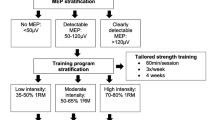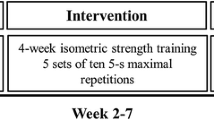Abstract
Stroke induces bilateral neurological impairment and muscle weakness yielding neurologically more (MA; paretic) and less affected (LA; non-paretic) sides. “Cross-education” refers to training one side of the body to increase strength in the same muscles on the untrained side. Past work showed dorsiflexion training of the LA side produced bilateral strength increases after stroke. The current study explored the presence and extent of cross-education after arm strength training in chronic stroke. Twenty-four chronic stroke participants completed 5 weeks of maximal wrist extension training using their LA arm. Maximal voluntary contraction force, arm motor impairment and functional performance were measured before and after training. Both spinal cord plasticity (n = 12: reciprocal inhibition and cutaneous reflexes, University of Victoria) and cortical plasticity (n = 12: cortical silent period, short-interval intracortical inhibition, intracortical facilitation and transcallosal inhibition, University of British Columbia) were assessed. Five weeks after training, 20 participants completed a follow-up maximal wrist extension retention test. LA wrist extension force increased 42% and MA by 35%. Strength gains were maintained in the follow-up test. Clinically meaningful increases in Fugl-Meyer scores were noted in four participants. Muscle activation was correlated with cutaneous reflex amplitudes after training in the MA arm. LA cortical silent period and transcallosal inhibition from both hemispheres significantly decreased after training. This study shows that high-intensity training with the neurologically less affected “non-paretic” arm can improve strength bilaterally and alter both spinal and cortical plasticity. The extent to which this plasticity can be enhanced or functionally exploited remains to be examined.






Similar content being viewed by others
References
Ada L, Dorsch S, Canning CG (2006) Strengthening interventions increase strength and improve activity after stroke: a systematic review. Aust J Physiother 52(4):241–248. https://doi.org/10.1016/S0004-9514(06)70003-4
Baldissera F, Bellani G, Cavallari P, Lalli S (2000) Changes in the excitability of the H-reflex in wrist flexors related to the prone or supine position of the forearm in man. Neurosci Lett 295:105–108. https://doi.org/10.1016/S0304-3940(00)01604-9
Barss TS, Klarner T, Pearcey GE, Sun Y, Zehr EP (2018) Time course “dose” of inter-limb strength transfer after hand grip training. J Appl Physiol (submitted)
Brouwer BJ, Schryburt-brown K (2006) Hand function and motor cortical output poststroke: are they related ? Arch Phys Med Rehabil 87:627–634. https://doi.org/10.1016/j.apmr.2006.02.006
Butefisch C, Hummelsheim H, Denzler P, Mauritz K-H (1995) Repetitive training of isolated movements improves the outcome of motor rehabilitation of the centrally paretic hand. J Neurol Sci 130:59–68
Celnik P, Hummel F, Harris-love M, Wolk R, Cohen G, L (2007) Somatosensory stimulation enhances the effects of training functional hand tasks in patients with chronic stroke. Arch Phys Med Rehabil 88:1369–1376. https://doi.org/10.1016/j.apmr.2007.08.001
Chen R, Tam A, Butefisch C, Corwell B, Ziemann U, Rothwell JC, Cohen LG (1998) Intracortical inhibition and facilitation in different representations of the human motor cortex. J Neurophysiol, 2870–2881
Classen J, Schnitzler A, Binkofski F, Werhahn KJ, Kim Y, Kessler KR, Benecke R (1997) The motor syndrome associated with exaggerated inhibition within the primary motor cortex of patients with hemiparetic stroke. Brain 120:605–619
Dragert K, Zehr EP (2011) Bilateral neuromuscular plasticity from unilateral training of the ankle dorsiflexors. Exp Brain Res 208(2):217–227. https://doi.org/10.1007/s00221-010-2472-3
Dragert K, Zehr EP (2013) High-intensity unilateral dorsiflexor resistance training results in bilateral neuromuscular plasticity after stroke. Exp Brain Res 225:93–104. https://doi.org/10.1007/s00221-012-3351-x
Farthing JP, Zehr EP (2014) Restoring symmetry: clinical applications of cross-education. Exerc Sport Sci Rev 42(2):70–75
Flansbjer UB, Miller M, Downham D, Lexell J (2008) Progressive resistance training after stroke: effects on muscle strength, muscle tone, gait performance and perceived participation. J Rehabil Med 40:42–48. https://doi.org/10.2340/16501977-0129
Flansbjer UB, Lexell J, Brogårdh C (2012) Long-term benefits of progressive resistance training in chronic stroke: a 4-year follow-up. J Rehabil Med 44:218–221. https://doi.org/10.2340/16501977-0936
Gladstone DJ, Danells CJ, Black SE (2002) The Fugl-Meyer assessment of motor recovery after stroke: a critical review of its measurement properties. Neurorehabil Neural Repair 16(3):232–240
Goodwill AM, Rearce JA, Kidgell JD (2012) Corticomotor plasticity following unilateral strength training. Neuroplast Exerc. https://doi.org/10.1002/mus.23316
Halperin I, Chapman DW, Behm DG (2015) Non-local muscle fatigue: effects and possible mechanisms. Eur J Appl Physiol 115:2031–2048. https://doi.org/10.1007/s00421-015-3249-y
Harris-love ML, Chan E, Dromerick AW, Cohen LG (2016) Neural substrates of motor recovery in severely impaired stroke patients with hand paralysis. Neurorehabil Neural Repair 30(4):328–338. https://doi.org/10.1177/1545968315594886
Hodics TM, Nakatsuka K, Upreti B, Alex A, Smith PS, Pezzullo JC (2012) Wolf motor function test for characterizing moderate to severe hemiparesis in stroke patients. Arch Phys Med Rehabil 93(11):1963–1967. https://doi.org/10.1016/j.apmr.2012.05.002
Hortobagy T, Lambert NJ, Hill JP (1997) Greater cross education following training with muscle lengthening than shortening. Med Sci Sport Exerc 29(1):107–112
Hortobagyi T, Scott K, Lambert J, Hamilton G, Tracy J (1999) Cross-education of muscle strength is greater with stimulated than voluntary contractions. Mot Control 3:205–219
Hortobagyi T, Taylor JL, Petersen NT, Russell G, Gandevia SC, Gandevia SC (2003) Changes in segmental and motor cortical output with contralateral muscle contractions and altered sensory inputs in humans. J Neurophysiol 90:2451–2459. https://doi.org/10.1152/jn.01001.2002
Hortobagyi T, Richardson SP, Lomarev M, Shamin E, Meunier S, Russman H, Hallett M (2011) Interhemispheric plasticity in humans. Med Sci Sport Exerc 43(7):1188–1199. https://doi.org/10.1249/MSS.0b013e31820a94b8.Interhemispheric
Inghilleri M, Berardelli A, G Cruccu, M Manfredi (1993) Silent period evoked by transcranial stimulation of the human cortex and cervicomedullary junction. J Physiol 466:521–534
Kaupp C, Pearcey GE, Klarner T, Sun Y, Cullen H, Barss TS, Zehr EP (2018) Rhythmic arm cycling training improves walking and neurological integrity in chronic stroke—the arms can give legs a helping hand in rehabilitation. J Neurophysiol 119:1095–1112. https://doi.org/10.1152/jn.00570.2017
Kidgell DJ, Frazer AK, Rantalainen T, Ruotsalainen I, Ahtiainen J, Avela J, Howatson G (2015) Increased cross-education of muscle strenght and reduced corticospinal inhibition following eccentric strength training. Neuroscience 300:566–575. https://doi.org/10.1016/j.neuroscience.2015.05.057
Kido A, Tanaka N, Stein RB (2004) Spinal reciprocal inhibition in human locomotion. J Appl Physiol 96:1969–1977. https://doi.org/10.1152/japplphysiol.01060.2003
Klarner T, Barss T, Sun Y, Kaupp C, Beattie S, Zehr EP (2014) Reliability of multiple baseline measures for locomotor retraining after stroke. Replace, repair, restore, relieve-bridging clinical and engineering solutions in neurorehabilitation. Biosyst Biorobotic 7:479–486. https://doi.org/10.1007/978-3-319-08072-7
Klarner T, Barss TS, Sun Y, Kaupp C, Loadman PM, Zehr EP (2016a) Exploiting interlimb arm and leg connections for walking rehabilitation: a training intervention in stroke. Neural Plast 2016:1517968. https://doi.org/10.1155/2016/1517968
Klarner T, Barss TS, Sun Y, Kaupp C, Loadman PM, Zehr EP (2016b) Long-term plasticity in reflex excitability induced by five weeks of arm and leg cycling training after stroke. Brain Sci 6:54. https://doi.org/10.3390/brainsci6040054
Kujirai T, Carramia MD, Rothwell JC, Day BL, Thompson PD, Ferbert A, Marsden CD (1993) Corticocortical inhibition in human motor cortex. J Physiol 471:501–519
Latella C, Kidgell DJ, Pearce AJ (2012) Reduction in corticospinal inhibition in the trained and untrained limb following unilateral leg strength training. Eur J Appl Physiol 112:3097–3107. https://doi.org/10.1007/s00421-011-2289-1
Lee M, Carroll TJ (2007) Cross education possible mechanisms for the contralateral effects of unilateral resistance training. Sports Med 37(1):1–14
Lin K, Hsieh Y, Wu C, Chen C, Jang Y, Liu J (2009) Minimal detectable change and clinically important difference of the Wolf Motor Function Test in stroke patients. Rehabil Neural Repair 23(5):429–434
A Manca, D Dragone, Z Dvir, F Deriu (2017) Cross-education of muscular strength following unilateral resistance training: a meta-analysis. Eur J Appl Physiol 117(11):2335–2354. https://doi.org/10.1007/s00421-017-3720-z
Mang CS, Borich MR, Brodie SM, Brown KE, Snow NJ, Wadden KP, Boyd LA (2015) Clinical Neurophysiology Diffusion imaging and transcranial magnetic stimulation assessment of transcallosal pathways in chronic stroke. Clin Neurophysiol 126(10):1959–1971. https://doi.org/10.1016/j.clinph.2014.12.018
Mogk J, Keir P (2003) The effects of posture on forearm muscle loading during gripping. Ergonomics 46(9):956–975. https://doi.org/10.1080/0014013031000107595
Munn J, Herbert RD, Gandevia SC (2004) Contralateral effects of unilateral resistance training: a meta-analysis. J Appl Physiol 96:1861–1866. https://doi.org/10.1152/japplphysiol.00541.2003
Nudo RJ, Friel KM, Delia SW (2000) Role of sensory deficits in motor impairments after injury to primary motor cortex. Neuropharmacology 39:733–742
Page SJ, Fulk GD, Boyne P, Page SJ, Fulk GD, Boyne P (2012) Clinical importance differences for the upper-extremity Fugl-Meyer scale in people with minimal to moderate impairment due to chronic stroke. Phys Ther 92(6):791–798. https://doi.org/10.2522/ptj.20110009
Patten C, Lexell J, Brown HE (2004) Weakness and strength training in persons with poststroke hemiplegia: rationale, method, and efficacy. J Rehabil Res Dev 41(3):293–312
Richards LG, Olson B, Palmiter-Thomas P (1996) How forearm position affects grip strength. Am J Occup Therapy 50(2):133–138
Sale D, MacDougall D (1981) Specificity in strength training:a review for the coach and athlete. Can J Sport Sci 6(2):87–92
Scripture E, Smith TL, Brown EM (1894) On education of muscular control and power. Stud Yale Psychol Lab 2:114–119
Shimizu T, Hosaki A, Hino T, Sato M, Komori T, Hirai S, Rossini PM (2002) Motor cortical disinhibition in the unaffected hemisphere after unilateral cortical stroke. Brain 125:1896–1907
Sun Y, Boots J, Zehr EP (2015) The lingering effects of a busted myth- false time limits in stroke rehabilitation. Appl Physiol Nutr Metab 40(8):858–861
Terrell R, Purswell JL (1976) The influence of forearm and wrist orientation on static grip strength as a design criterion for hand tools. In: Proceedings of the human factors and ergonomics society annual meeting, vol 20, No 1, pp 28–32
Thompson AK, Estabrooks KL, Chong S, Stein RB (2008) Spinal reflexes in ankle flexor and extensor muscles after chronic central nervous system lesions and functional electrical stimulation. Neurorehabil Neural Repair 23(2):133–143. https://doi.org/10.1177/1545968308321067
Urbin MA, Harris-love ML, Carter AR, Lang CE (2015) High-intensity, unilateral resistance training of a non-paretic muscle group increases active range of motion in a severely paretic upper extremity muscle group after stroke. Front Neurol. https://doi.org/10.3389/fneur.2015.00119
Veldman MP, I Zijdewind, Solnik S, NA Maffiuletti, KMM Berghuis, M Javet, T Hortobagyi (2015) Direct and crossed effects of somatosensory electrical stimulation on motor learning and neuronal plasticity in humans. Eur J Appl Physiol 115:2505–2519. https://doi.org/10.1007/s00421-015-3248-z
Winstein CJ, Rose DK, Tan SM, Lewthwaite R, Chui HC, Azen SP (2004) A randomized controlled comparison of upper-extremity rehabilitation strategies in acute stroke: a pilot study of immediate and long-term outcomes. Arch Phys Med Rehabil 85:620–628. https://doi.org/10.1016/j.apmr.2003.06.027
Wolf SL, Catlin PA, Ellis M, Archer AL, Morgan B, Piacentino A (2001) Assessing Wolf motor function test as outcome measure for research in patients after stroke. Stroke 32:1635–1640
Yang Y-R, Wang R-Y, Lin K-H, Chu M-Y, Chan R-C (2006) Task-oriented progressive resistance strength training improves muscle strength and functional performance in individuals with stroke. Clin Rehabil 20:860–870
Yue GH, Cole KJ (1992) Strength increases from the motor program: comparison of training with maximal voluntary and imagined muscle contractions. J Neurophysiol 67(5):1114–1123
Zehr EP (2002) Considerations for use of the Hoffmann reflex in exercise studies. Eur J Appl Physiol 86:455–468. https://doi.org/10.1007/s00421-002-0577-5
Zehr EP (2006) Training-induced adaptive plasticity in human somatosensory reflex pathways. J Appl Physiol 101:1783–1794. https://doi.org/10.1152/japplphysiol.00540.2006
Zehr EP (2011) Evidence-based risk assessment and recommendations for physical activity clearance: stroke and spinal cord injury. Appl Physiol Nutr Metab 36:S214-231. https://doi.org/10.1139/h11-060
Zehr EP, Kido A (2001) Neural control of rhythmic, cyclical human arm movement: task dependency, nerve specificity and phase modulation of cutaneous reflexes. J Physiol 537(3):1033–1045. https://doi.org/10.1111/j.1469-7793.2001.01033.x
Zehr EP, Barss TS, Dragert K, Frigon A, Vasudevan EV, Haridas C, Komiyama T (2016) Neuromechanical interactions between the limbs during human locomotion: an evolutionary perspective with translation to rehabilitation. Exp Brain Res 234(11):3059–3081. https://doi.org/10.1007/s00221-016-4715-4
Zhou S (2000) Chronic neural adaptations to unilateral exercise mechanisms of cross education. Exerc Sport Sci Rev 28(4):177–184
Acknowledgements
Dr. E.Paul Zehr’s research was supported by funding from the Heart and Stroke Foundation (British Columbia and Yukon). Yao Sun was supported by a Focus on Stroke doctoral award from the Heart and Stroke Foundation of Canada. Data collection at UBC was funded by an operating grant from the Canadian Institutes of Health Research operating Grant (MOP-106651) awarded to Dr. Lara Boyd. The authors also wish to acknowledge Matt Jensen’s contribution in designing, making and instrumenting the training devices.
Author information
Authors and Affiliations
Corresponding author
Ethics declarations
Conflict of interest
The authors declare no competing financial interests.
Rights and permissions
About this article
Cite this article
Sun, Y., Ledwell, N.M.H., Boyd, L.A. et al. Unilateral wrist extension training after stroke improves strength and neural plasticity in both arms. Exp Brain Res 236, 2009–2021 (2018). https://doi.org/10.1007/s00221-018-5275-6
Received:
Accepted:
Published:
Issue Date:
DOI: https://doi.org/10.1007/s00221-018-5275-6




